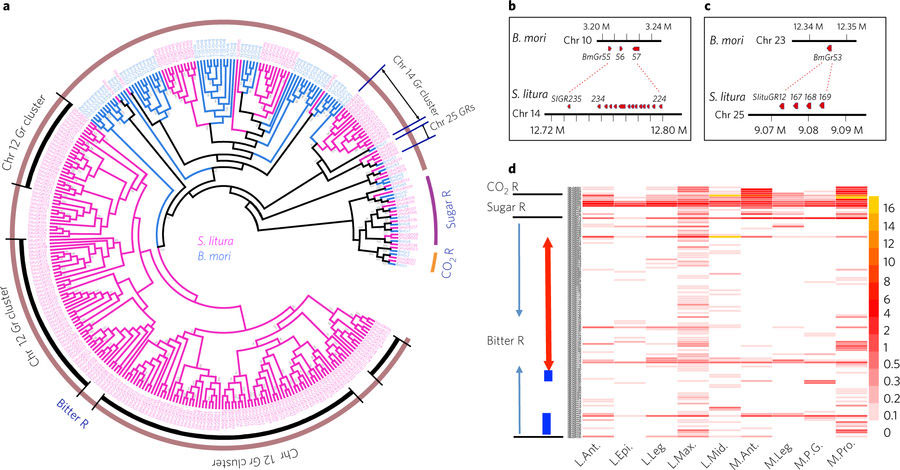東アジアの重要害虫であるヤガ類のゲノムに見られる多食性および殺虫剤への適応 OPEN
Genomic adaptation to polyphagy and insecticides in a major East Asian noctuid pest
2017年9月25日 Nature Ecology & Evolution 1 : 1747 doi: 10.1038/s41559-017-0314-4

ハスモンヨトウ(Spodoptera litura)は、最も広く重大な被害をもたらしている農業害虫の1つであり、熱帯および亜熱帯アジア全域で100種類以上の作物を食害する。今回我々は、ゲノム塩基配列解読、物理的マッピングおよびトランスクリプトーム解析により、この多食性昆虫種では、苦味物質もしくは有毒物質の受容体や、シトクロムP450、カルボキシルエステラーゼおよびグルタチオン-Sトランスフェラーゼなどの解毒酵素をコードする複数の遺伝子ファミリーが大幅に拡張されており、それによって、多くの植物二次化合物を検知および解毒できる極めて優れた能力を得ていることを見いだした。幼虫を殺虫性の毒素に暴露すると解毒遺伝子の発現が誘導され、そのうち代表的な遺伝子の発現を低分子干渉RNA(siRNA)で抑制すると幼虫の生存率が低下した。この結果は、これらの遺伝子がハスモンヨトウの生得的な農薬耐性に寄与していることと整合する。ある集団遺伝学研究から、この種はインド南部-中国南部-日本の軸に沿って移動して、多様な宿主植物や殺虫剤が存在する幅広い生態学的条件に適応し、その拡張された解毒系の助けを得て生存および適応することによって、東南アジア全域に広がったことが示されている。本研究の知見によって、ハスモンヨトウをはじめとする重要な農業害虫を防除するための新たな害虫管理戦略の開発が可能になると考えられる。
Corresponding Authors
The tobacco cutworm, Spodoptera litura, is among the most widespread and destructive agricultural pests, feeding on over 100 crops throughout tropical and subtropical Asia. By genome sequencing, physical mapping and transcriptome analysis, we found that the gene families encoding receptors for bitter or toxic substances and detoxification enzymes, such as cytochrome P450, carboxylesterase and glutathione-S-transferase, were massively expanded in this polyphagous species, enabling its extraordinary ability to detect and detoxify many plant secondary compounds. Larval exposure to insecticidal toxins induced expression of detoxification genes, and knockdown of representative genes using short interfering RNA (siRNA) reduced larval survival, consistent with their contribution to the insect’s natural pesticide tolerance. A population genetics study indicated that this species expanded throughout southeast Asia by migrating along a South India–South China–Japan axis, adapting to wide-ranging ecological conditions with diverse host plants and insecticides, surviving and adapting with the aid of its expanded detoxification systems. The findings of this study will enable the development of new pest management strategies for the control of major agricultural pests such as S. litura.

